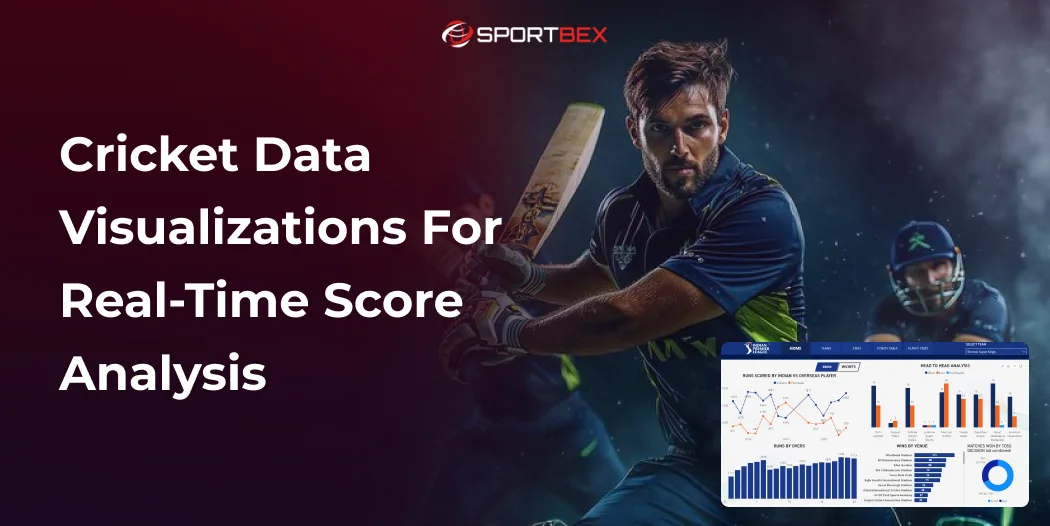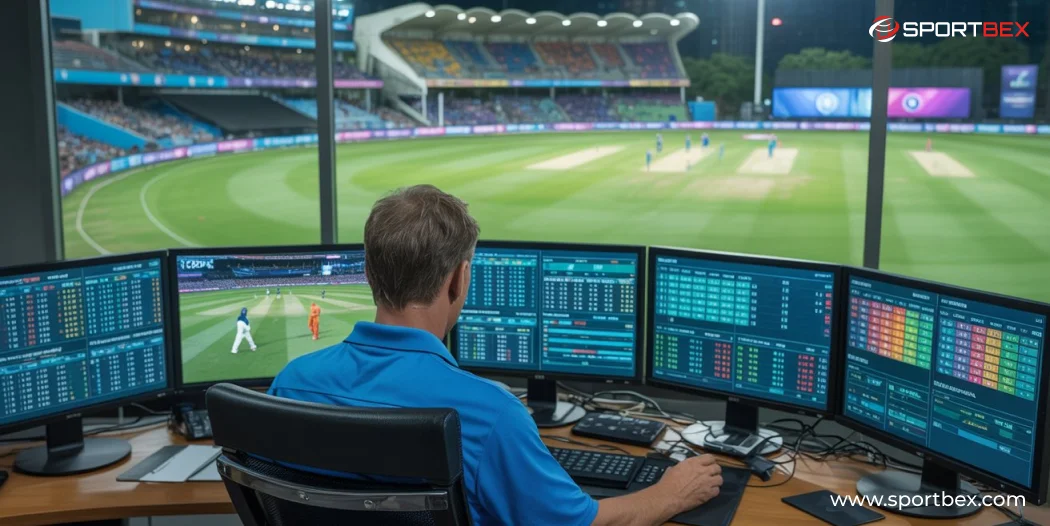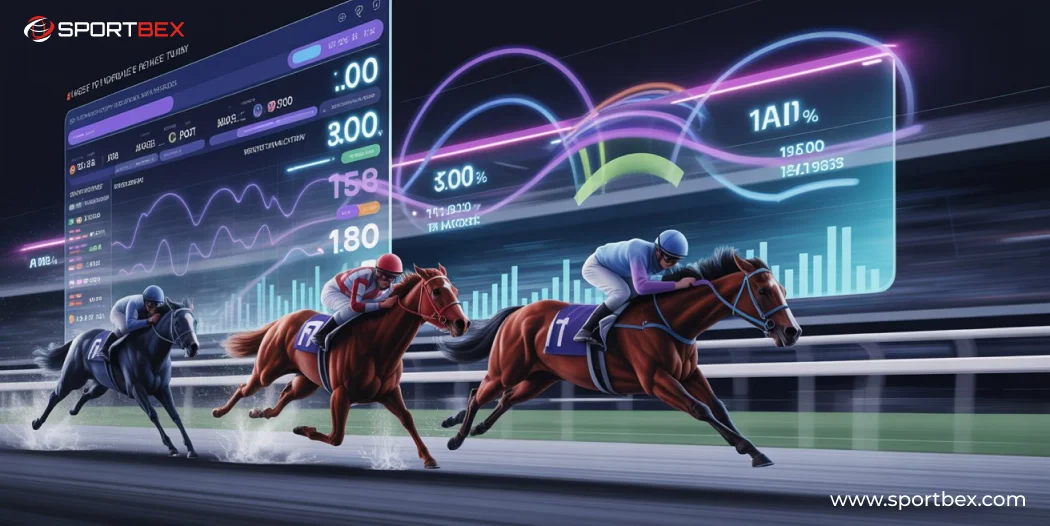Cricket has always had a lot of data. Every game creates tons of information, like runs, wickets, strike rates, and partnerships. But just raw data isn’t enough. To make good choices, whether you’re a fan, coach, or analyst, the data needs to be clear. This is where cricket data visualization helps.
It turns complicated numbers into easy-to-understand graphs, dashboards, and charts. This gives us quick insights that change how we experience the game.
Today, technology is a big part of sports analysis. Sports data visualization makes games more fun for fans and gives teams smart ideas they couldn’t get before. With live updates and cool pictures, fans can watch the game as it happens. Coaches and analysts can make decisions based on data right away.
Using tools like Sports Data API, apps can fetch live scores and stats seamlessly. Also, apps that show Live Cricket Data Visualizations are changing how people connect with cricket. They make the sport easier to understand and more exciting.
What Are Cricket Data Visualizations?
Cricket data visualization is about showing cricket game information using pictures, like graphs. Instead of looking at many numbers, people can quickly see patterns and how players are doing. This is part of a bigger idea called data visualization in sports. It turns numbers into easy-to-understand charts and interactive sports graphs.
For example, instead of just knowing a player scored 50 runs, cricket data visualization can show how they scored those runs, such as over time, against different bowlers, or in different overs. This helps teams study player strengths and weaknesses, and fans understand the game better. Modern platforms also include Cricket Score Widget features, giving live updates on websites and apps with easy-to-read visuals.
Why Real-Time Score Analysis Matters
Cricket is a fast game where plans can change with every ball. Real-time score analysis helps everyone involved stay on top of the game! Coaches can watch how players are doing right then, make quick changes to bowling or batting, and switch up their plans to beat the other team. And for fans? They can follow the game’s progress without missing a single moment.
Live Cricket Data Visualizations offer real-time updates presented through easy-to-understand and dynamic graphics. This means that instead of simply seeing the score change, viewers can actively follow various trends within the game, such as accelerating run rates during a power play, the formation of strong batting partnerships, or identifying a bowler’s most effective areas of attack on the pitch.
This comprehensive visual approach makes the game of cricket significantly more exciting, interactive, and easier to follow, benefiting both casual fans watching at home and professional analysts studying the intricacies of the game.
Benefits of Using Real-Time Data Visualizations
Using live cricket data visualizations offers great benefits to everyone in the sport. It’s not just about visuals but about creating real value. Here are the key advantages!
Enhances Fan Engagement
Interactive cricket data visualization graphs truly transform the fan experience, allowing enthusiasts to follow every aspect of the game with unprecedented depth. By clearly visualizing ball-by-ball action, intricate partnerships between batsmen, and detailed player statistics, fans feel a much stronger connection to the game.
This immersive approach allows them to enjoy a richer and more informed viewing experience, moving beyond mere spectatorship to a more analytical and engaging participation.
Provides Insights for Better Strategies
Teams can make much smarter, data-driven decisions when they have access to real-time information! Imagine a coach analyzing dynamic sports graphs of individual player performance; this allows them to strategically adjust batting orders mid-game or precisely select bowlers to target specific, vulnerable batsmen. It’s all about gaining that competitive edge through clear, immediate insights!
Improves App/Website User Experience
Cricket data visualization graphs are perfect for this. They’re eye-catching, simple, and deliver valuable information instantly! A live dashboard with these visuals can make your platform the ultimate hub for cricket fans. Imagine a Cricket Score Widget offering seamless, engaging updates!
Helps Developers Build Smarter Platforms
Imagine a tool that forecasts final scores or a player’s century probability by analyzing historical and live data! A reliable Sports Data API is your secret weapon, providing the structured data to power these innovative applications. This isn’t just about user engagement; it’s about showcasing your cutting-edge tech skills!
Key Features of Cricket Data Visualizations
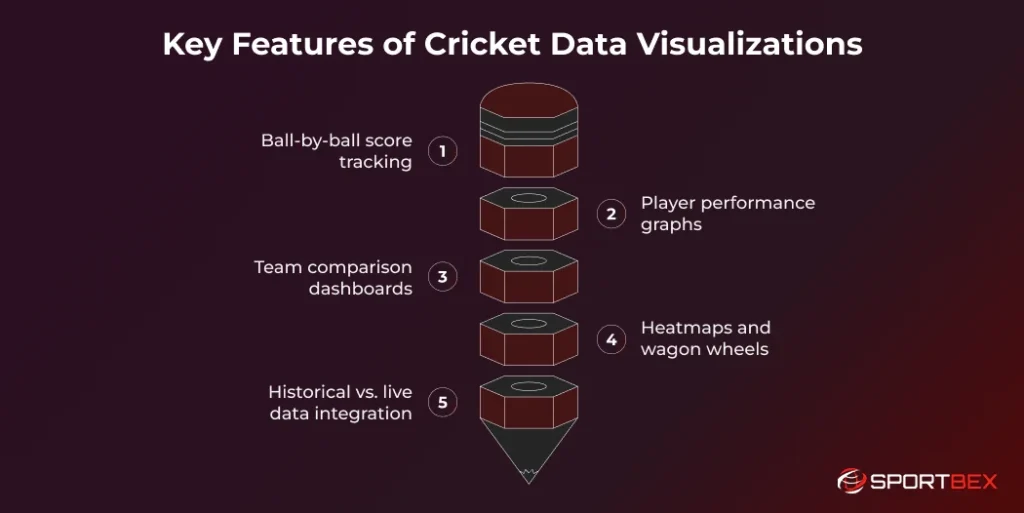
Cricket data visualizations need powerful features! These tools transform raw data into compelling stories. Let’s explore the must-have features that make these visualizations so effective.
Ball-by-Ball Score Tracking
This feature is super important for truly immersing yourself in a live game! Just imagine a dynamic, moving chart that graphically illustrates what happens with every single ball bowled. Did the batsman score runs, or did a crucial wicket fall? It’s like watching the very heartbeat of the game, ball by ball, unfold right in front of your eyes!
Player Performance Graphs
Want to know how well a player is doing? Player performance graphs show you! You can see charts of a batsman’s runs, a bowler’s economy (how few runs they give away), or how fast they score against different types of bowling. These pictures help you quickly see how important a player is in the game and how they compare to their past games or other players.
Team Comparison Dashboards
Who’s winning the game? Team comparison dashboards show the performance of both teams side-by-side. They include simple charts like run rate graphs, partnership stats, and fall of wickets. These visuals make it easy to see momentum changes and key moments shaping the match. It’s a clear and exciting way to follow the competition.
Heatmaps and Wagon Wheels
These are some of my favorite ways to see cricket data!
- Heatmaps are great for showing how accurate a bowler is. They use colors to show where the bowler has thrown the ball most often. This helps you quickly see if a bowler is throwing consistently well or all over the place.
- Wagon Wheels are excellent for understanding how a batsman scores. They show where a batsman hits the ball, highlighting their favorite scoring spots and any areas where they might struggle. It gives a full picture of their batting style.
Historical vs. Live Data Integration
This is where things get really interesting. The best sports data visualization platforms integrate historical data, not just current events. Imagine seeing a player’s performance against their career average, or comparing a team’s current run chase to famous past successes. This adds incredible depth, aiding accurate predictions and connecting the present to the game’s rich history.
Types of Cricket Data Visualizations
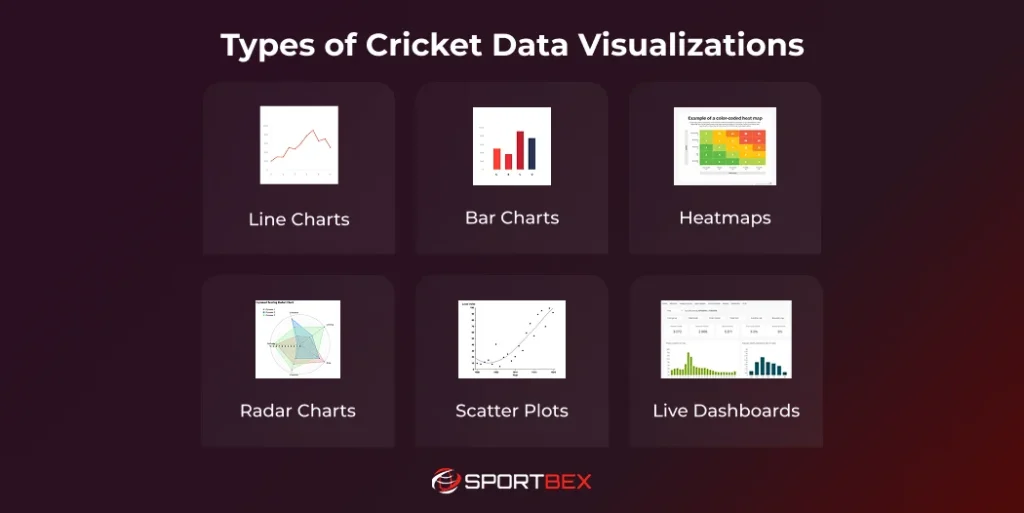
Cricket matches can be visualized in many ways, each suited to telling a different part of the story. Here are some of the most popular types you’ll come across.
Line Charts
Line charts are great for showing how things change over time. In cricket, they’re often used to compare run rates, like “worm graphs.” You’ll see two lines, one for each team, showing their total score after each over. This helps you quickly see which team is winning, when things changed, and if the team is scoring fast enough. They’re simple to understand and show how the game is unfolding.
Bar Charts
Bar charts are great for making comparisons. You can use them to compare things like top run-scorers or leading wicket-takers in a match or series. They’re also useful for showing runs scored in each over (a Manhattan chart) or comparing two players on stats like strike rate or economy. They’re clear and easy to read, making them perfect for quick analysis.
Heatmaps
Heatmaps are excellent for showing where things are concentrated. For example, a bowler’s pitch map can show where they usually land the ball. For batsmen, a heatmap on the field can show where they hit the ball most often to score runs. The different colors, from blue (less frequent) to red (more frequent), help you quickly see these patterns.
Radar Charts
Radar charts, also called spider charts, are useful for comparing different stats for a player or team. For example, you can use one to show how a batsman performs in areas like strike rate, boundary percentage, average, and consistency. By putting two players’ charts side by side, you can easily see their strengths and weaknesses at a glance.
Scatter Plots
Scatter plots show how two different things relate to each other. For example, you can use them to see if a bowler’s speed affects how much the ball swings. This helps find out if there’s a best speed for them. Scatter plots are great for finding hidden patterns in data.
Live Dashboards
Imagine all these cool charts and graphs, constantly updating during the game! That’s a Live Dashboard. It’s your personal control center, showing scores, player performance, and even wagon wheels! You get a full, 360-degree view of the game in real time, which is super exciting for any cricket fan. These dashboards are powered by Sports Data Feeds, a constant stream of fresh data that keeps everything current and thrilling!
Tools and Technologies for Cricket Data Visualization
Building these cricket data visualizations requires the right tools. From data collection to chart creation, much happens behind the scenes. Let’s explore the key components that make it all possible.
Cricket APIs
Everything starts with data. A reliable, fast, and accurate API (Application Programming Interface) is very important. A Real-Time Cricket Data API is the foundation of any live score or visualization platform. It sends ball-by-ball updates, player stats, and match details in an easy-to-use format like JSON or XML. Developers use this data to power their tools. Without a good API, real-time updates wouldn’t work.
Visualization Libraries
When it comes to showing cricket data in a cool way, visualization libraries are super helpful! Python tools like Matplotlib and Plotly, or R tools like ggplot2, are often used to make awesome cricket data visualization graphs. These tools are famous for making beautiful graphs that look great in reports and help everyone understand tricky data easily.
AI & Machine Learning
AI and ML are revolutionizing cricket analytics. They process vast amounts of data to find patterns and make predictions. For instance, an ML model can predict match outcomes, batsman dismissals, or optimal field placements. AI can also enhance visualizations with predictive overlays, like projected score ranges. Some platforms even use an Odds API Provider to integrate betting probabilities, often powered by sophisticated ML models.
Cloud Platforms
Handling and sharing all this data in real time needs a lot of computing power. Cloud platforms like Amazon Web Services (AWS), Google Cloud (GCP), and Microsoft Azure provide the tools needed to do this. They help with storing data, processing it, and running apps and services. The cloud makes sure the system can handle big spikes in traffic, like during a World Cup final, without crashing, so users everywhere get a smooth experience.
The Future of Cricket Data Visualizations
Sports analytics is evolving fast, and cricket data visualization is leading the way. The future promises exciting innovations like Augmented Reality (AR) and Virtual Reality (VR), making games more immersive and interactive.
You point your phone at your TV and instantly see player stats and data visualizations overlaid on the live match. Or, you put on a VR headset and step into a virtual stadium, accessing any data dashboard as if you’re part of the team’s analytics crew. These Sports Technology Trends are transforming how fans engage with the game, creating a more personalized and immersive experience.
Get ready for mind-blowing AI predictions, from every bowl to every shot! These insights will pop up seamlessly on your screen, adding a whole new level of excitement. Imagine seeing players’ heart rates during a nail-biting moment or their fatigue levels in real-time – how cool is that?! It’s all about creating a super complete picture of the game, blending the action with the human story, all through stunning visuals.
Get a Ready-Made Platform On Rent.
Get Started Today
Conclusion
Cricket is more than just a game; it’s a sport filled with data, where every ball, run, and wicket tells a story. Cricket data visualization turns this complex information into clear, interactive, and easy-to-understand formats that benefit fans, coaches, analysts, and developers alike. From detailed sports graphs and cricket data visualization graphs to Live Cricket Data Visualizations, these tools allow everyone to follow the match in real time, make better strategic decisions, and enjoy a richer viewing experience.
With APIs like the Real-Time Cricket Data API and interactive widgets such as the Cricket Score Widget, live analysis has never been easier. Many platforms even offer a Free trail, letting fans and analysts explore dashboards, player stats, and match insights before committing. As technology continues to evolve, cricket analytics is becoming faster, smarter, and more immersive, giving everyone the ability to experience and understand the game like never before.
Frequently Asked Questions
Live cricket analysis uses Real-Time Cricket Data API to capture ball-by-ball data, which is displayed in dashboards and visualizations for instant insights during the match.
APIs like Sports Data API, Sports Data Feeds, and Real-Time Cricket Data API deliver live scores, player stats, and match analytics for real-time updates and analysis.
Sports graphs display player performance, team comparisons, scoring trends, and match progress, helping analysts and coaches make better decisions quickly.
Yes, fans can track matches live, view player stats, and compare historical performance using dashboards and widgets like Cricket Score Widget for interactive insights.
Real-time data helps coaches make strategic decisions, enhances fan engagement, and allows apps or websites to provide live, interactive insights for matches.
Recent Blog
What Makes the Cricket Exchange API Valuable for Operators?
November 19, 2025
 9 min
9 min
The Role of Real-Time Data APIs in Horse Racing Prediction
November 19, 2025
 9 min
9 min


